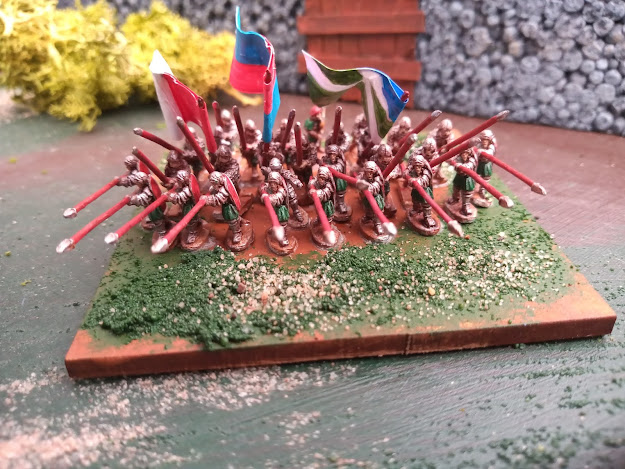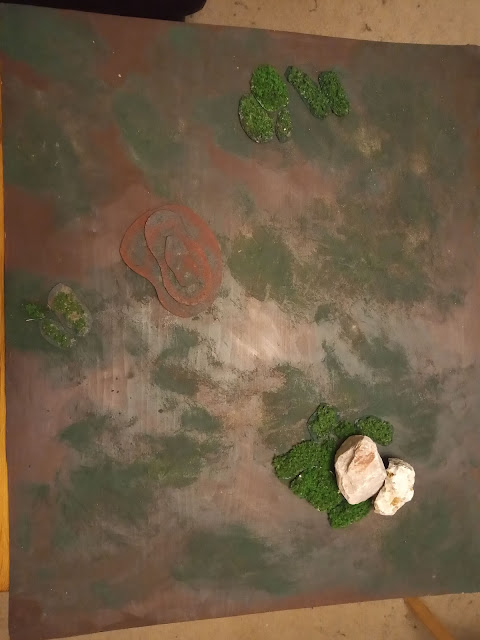Hello all. This post will be a break from the thrilling nonhistory of the land of Olde Albilande and insted i will show you the modified rules i have been using for my battle reports so far on this blog. I have used these beauties:
To run the games i have posted on here so far. The main reasons i like these rules is they are quick, simple, highly customizable and because im too lazy to learn anything more complex. If you want to follow what on earth i am going on about in this post you will need a copy of these rules to have any real clue.
I like to muck about with them from game to game and am always tinkering away with ideas between play sessions. That being said there are a few things i like to include most of the time. As both reports i have published have used different mods i think it would be best to deal with them individually. However both do use the following:
Both games use the medieval section of the rules as a base...with a few other troop types from a few other periods chucked in.
The troop types i use are used 'out of the book' and are:
Knights, Men at arms, Leve and archers from the medieval section
Skirmishers, Warband and Cavalry from the Dark age rules
Artillery from the Horse and Musket rules.
I also use a points system to choose forces. This is because the rules below play better with larger forces than recomended in the book. Each unit is worth either 1 or 2 points:
Leve, archers, Skirmishers, Warband, Artillery and Cavalry are all worth 1 point.
Knights and Men at arms are worth 2 points.
You may not spend more than half your points total on units worth 2 points. A good total cost for an average sized army would be 10-15 points in the smaller scale rules. For the Larger scale rules a total army cost of 20-30 points split into 3 battles of at least 6 points each.
All the rules are used as stated in the book unless directly contradicted here.
1)The Battle of Rippletons Mound...or rules for smaller scale games.
Rippletons Mound, bit of a to do really.
use the rules as written with the following changes:
Sequence of play
1; Both players roll 1d6, highest roll choses who goes first (will be player A) this turn.
2; Player A chooses between his Movement or Shooting phase.
3; Player B chooses between his Movement or Shooting phase.
4; Player A's Movement or Shooting phase (which ever he did not choose in step 2).
5; Player B's Movement or Shooting phase (which ever he did not choose in step 3).
6; Hand to hand combat.
7; Morale Phase.
Movement rules remains unchanged.
Shooting rules remain unchanged with the exception of Archers no longer adding +2 to their attack dice.
If a unit recieves hits from shooting they must have a marker placed next to them to show they need to make a Morale check in the morale phase. Units only ever recieve one such marker per turn.
Hand to hand combat remains as written except both sides roll attacks at the same time in each combat. The unit in each combat that recieves the most hits that turn must have a marker placed next to them to show they need to make a Morale check in the morale phase. If the unit that caused the most hits has a marker for a morale test they may remove it.
Morale Phase
This Phase replaces the Eliminating Units phase
Players take it in turns to test the morale of any units they have with a marker showing a morale test is required. This is done by rolling 3D6 and comparing the result with the number of hits the unit has taken so far. Knights and Men at arms add 2 to the roll, Artillary, archers and Skirmishers minus 2 from it. If the result is greater than or equal to the number of hits the test is passed and the unit remains in play, remove the marker before the start of the next turn. If the result is less than the number of hits taken the unit breaks and is removed from play.
Army Morale Checks
Once both players have finished testing morale count the number of units each force has in play. If a players force contains less than 6 units they must take an army morale test.
To do this roll 1d6 + an extra 1d6 per unit of Knights or Men at arms the player still has on the table. If the result on any single dice is less than or equal to the number of units that player has on the table the test is passed. If the result is greater than that number on every single dice the army breaks and is removed from play, that player looses the battle as his army heads for the hills!.
Where both players have to check army morale in the same turn both roll all their dice at the same turn. If both players fail the test the player that rolls the lowest total on all his dice rolled breaks, his opponent wins a pyrrhic victory. Where the totals are tied both players break. The battle is a draw.
2) The Battle of Stremleys Pile...or rules for large scale dust ups!!.
A larger scale ding dong!.
Use the rules in the Medieval section with the following changes.
Army Organization
Armys are made up of 3 Battles each made up of at least 6 points worth of troops. Units within a battle deploy within 2 inches of at least one other unit of the same battle. This no longer applies once the game starts.
Sequence of play
1; Both players roll 1d6, the player who rolls highest is player A this turn, the other player is Player B this turn.
2; Player A chooses one of his battles and carries out either a movement phase or a shooting phase with that battle.
3: Player B chooses one of his battles and carries out either a movement phase or a shooting phase with that battle.
repeat 2 and 3 until all battles have carried out a movement or shooting phase. Once a battle has taken its chosen phase it may not take another this turn.
4; Hand to hand combat phase
5: Morale phase
Movement rules remains unchanged.
Shooting rules remain unchanged with the exception of Archers no longer adding +2 to their attack dice.
If a unit recieves hits from shooting they must have a marker placed next to them to show they need to make a Morale check in the morale phase. Units only ever recieve one such marker per turn.
Hand to hand combat remains as written except both sides roll attacks at the same time in each combat. The unit in each combat that recieves the most hits that turn must have a marker placed next to them to show they need to make a Morale check in the morale phase. If the unit that caused the most hits has a marker for a morale test they may remove it.
Morale Phase
This Phase replaces the Eliminating Units phase
Players take it in turns to test the morale of any units they have with a marker showing a morale test is required. This is done by rolling 3D6 and comparing the result with the number of hits the unit has taken so far. Knights and Men at arms add 2 to the roll, Artillary, archers and Skirmishers minus 2 from it. If the result is greater than or equal to the number of hits the test is passed and the unit remains in play, remove the marker before the start of the next turn. If the result is less than the number of hits taken the unit breaks and is removed from play.
Army Morale Checks
Once both players have finished testing morale count the number of units each force has in play. If a players force has lost a battle this turn they must take an army morale test.
To do this roll 1d3 + an extra 1d3 per remaining battle that contains Knights or Men at arms the player still has on the table. If the result on any single dice is less than or equal to the number of battles that player has on the table the test is passed. If the result is greater than that number on every single dice the army breaks and is removed from play, that player looses the game as his army heads for the hills!.
Where both players have to check army morale in the same turn both roll all their dice at the same turn. If both players fail the test the player that rolls the lowest total on all his dice rolled breaks, his opponent wins a pyrrhic victory. Where the totals are tied both players break. The battle is a draw.
So thats basically it. As i said before im often found tinkering with these rules so i will try to post any more changes if and when i remember them.
Hope this was in some way helpful.


















































